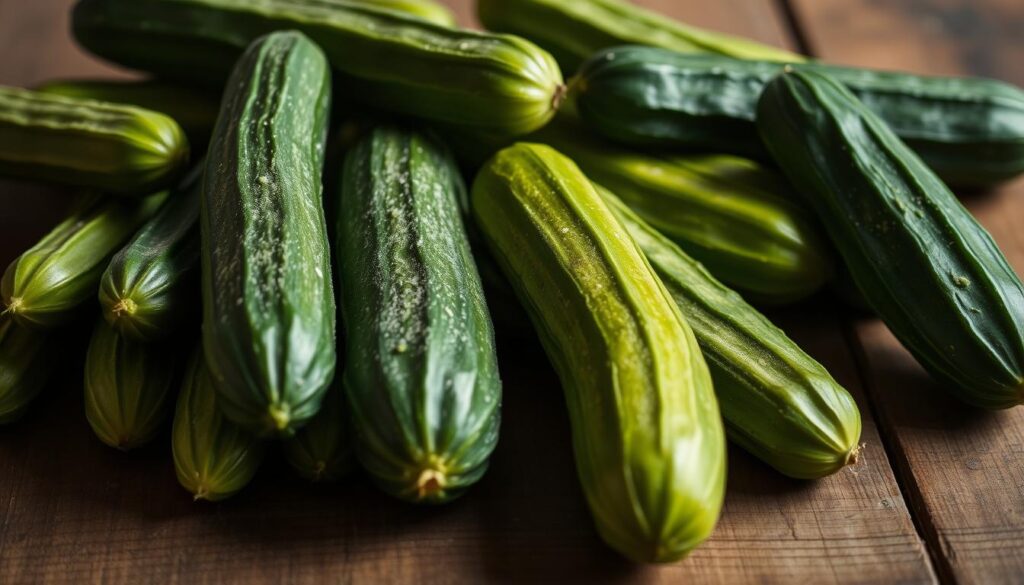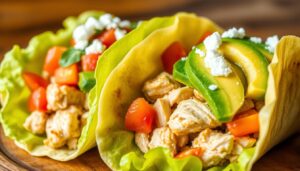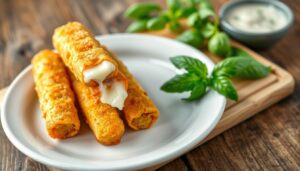Every summer, my grandmother’s kitchen became a magical place. The sound of glass jars and the smell of vinegar filled the air. These memories made me love pickling cucumbers.
Pickling cucumbers are different from regular cucumbers. They are perfect for making pickles that are crisp and full of flavor. Knowing the difference can make you a better pickler.
Let’s start your pickling journey. This guide will help you pick, prepare, and preserve delicious pickles. You’ll see how the right cucumber can change your pickling game.
Understanding the Art of Pickling Through History
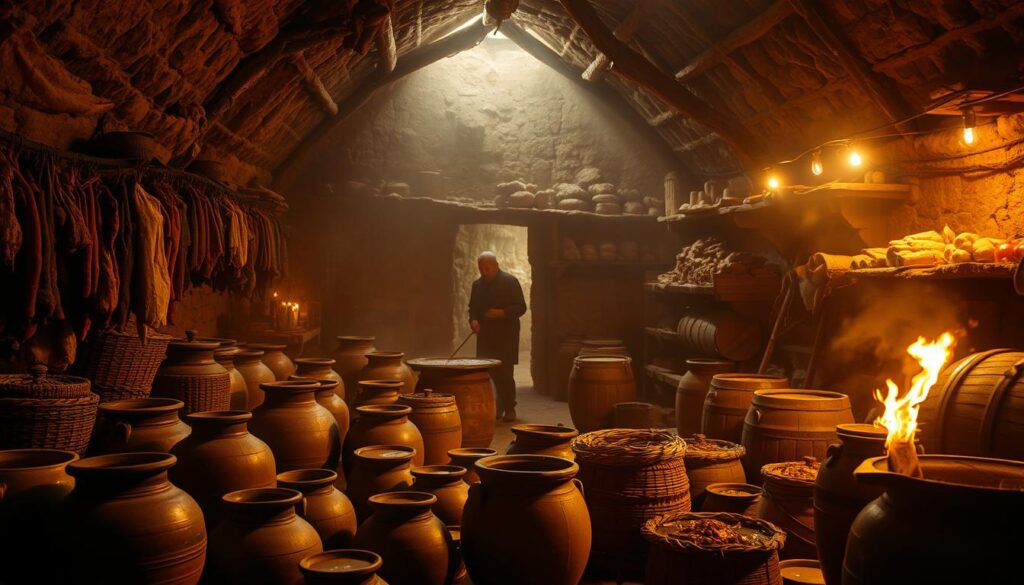
Pickling is a clever way to keep food fresh for a long time. It has been around for thousands of years. People long ago found that by pickling, they could make food last longer and taste better.
Roots of Ancient Preservation
The first signs of pickling were found in ancient Mesopotamia, around 2030 BC. People all over the world came up with ways to keep their food from going bad. Pickling was a key skill for survival.
- Babylonians pickled fish in brine
- Chinese cultures preserved vegetables using fermentation
- Romans spread pickling techniques throughout their empire
Cultural Significance Across Regions
Pickling was more than just a way to keep food fresh. It was a way to show off local traditions and use what was available. From Korean kimchi to German sauerkraut, each place had its own special way of preserving food.
Technological Evolution of Pickling
As time went on, pickling got more advanced. New things like vinegar, special containers, and understanding about bacteria made pickling a science.
“Pickling is not just about preservation, but about capturing culture in a jar.” – Traditional Culinary Wisdom
Essential Characteristics of Pickling Cucumbers
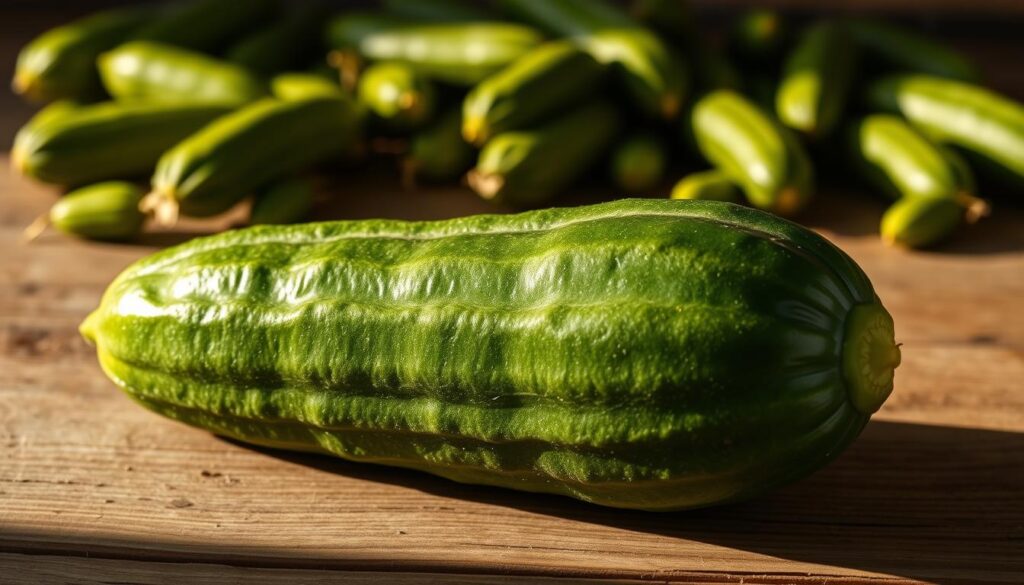
Exploring pickling cucumbers reveals their special traits for making tasty preserved veggies. They differ from regular cucumbers in key ways. These differences make them ideal for pickling and keeping fresh.
The main features of pickling cucumbers are:
- Smaller size compared to standard cucumber varieties
- Thicker, more robust skin that maintains crispness during pickling
- Denser flesh with fewer seeds
- Ability to absorb brines and seasonings more effectively
Pickling cucumbers are usually 2-4 inches long. Their small size makes them easy to pack in jars. This ensures even pickling. The thicker skin also helps keep them from getting mushy during pickling.
“The secret to perfect pickles lies in selecting the right cucumber variety” – Artisan Pickle Makers
When picking cucumbers for pickling, choose firm, dark green ones with few blemishes. These signs show they’re fresh and good for pickling. Local farmers markets and gardens often have the best pickling cucumbers.
Knowing these key traits helps turn regular cucumbers into amazing pickles. They’ll be full of flavor and keep their crunch.
The Science Behind Cucumber Varieties
Knowing the special traits of cucumber varieties is key to making great pickles. Each type has its own structure and makeup. These traits affect how well they pickle.
Not all cucumbers are good for pickling. Some are better than others. Choosing the right one is important for a tasty pickle.
Structural Differences That Matter
The body of cucumber varieties affects pickling. Important differences include:
- Cellular density
- Seed distribution
- Overall firmness
- Skin texture
Water Content Analysis
Water content is crucial for pickling. Pickling cucumbers have less water. This helps them stay crunchy and soak up brine better.
Skin Thickness Comparisons
Skin thickness is important for pickling. Thin-skinned cucumbers soak up flavors fast. Thicker-skinned ones offer a crunchy bite.
| Cucumber Variety | Water Content | Skin Thickness | Pickling Suitability |
|---|---|---|---|
| Kirby Cucumbers | Low | Medium | Excellent |
| English Cucumbers | High | Thin | Poor |
| Gherkin Cucumbers | Low | Thick | Perfect |
By knowing these details, you can pick the best cucumbers for pickling. This ensures your pickles are always crisp and flavorful.
Traditional vs Modern Pickling Methods
The pickling process has changed a lot from ancient times to now. Exploring fermentation methods shows how food preservation has evolved.
Old-fashioned pickling used natural methods passed down through generations. People used wooden barrels and clay crocks to make pickled veggies. They picked fresh veggies and made brines with salt, water, and spices.
- Wooden barrel fermentation allowed slow, natural preservation
- Salt concentration was carefully measured by hand
- Fermentation times varied based on family recipes
Today, pickling is more precise and efficient. Glass jars, controlled temperatures, and special tools make it easier. Now, you can control every step of pickling more accurately.
| Traditional Method | Modern Method |
|---|---|
| Wooden barrel fermentation | Sterile glass container preservation |
| Natural salt measurements | Precise digital measurements |
| Seasonal limitations | Year-round pickling capabilities |
Modern methods are convenient, but many love the artisanal approach of old pickling. Your choice depends on what you like, how much time you have, and how complex you want the flavors to be.
Selecting the Perfect Pickling Cucumbers
Choosing the right cucumbers is key to making tasty pickles. Whether you grow them or buy them, knowing how to pick the best cucumbers is crucial. It makes a big difference in how your pickles turn out.
For successful pickling, pay close attention to a few important factors. Not all cucumbers are good for pickling. They need to be just right for making crisp, flavorful pickles.
Size and Shape Guidelines
When picking cucumbers for pickling, look for these important traits:
- Ideal length: 2-4 inches long
- Firm and smooth skin texture
- Consistent dark green color
- Minimal bumps or irregularities
Freshness Indicators
Freshness is key when choosing cucumbers for pickling. Here are signs of the best quality:
| Freshness Indicator | What to Look For |
|---|---|
| Skin Appearance | Bright, vibrant green without yellowing |
| Firmness | Crisp to the touch, no soft spots |
| Weight | Heavy for their size, indicating high water content |
Seasonal Considerations
Timing is important in cucumber gardening for pickling. The best time is usually June to August. This is when local farms and gardens have the biggest and best cucumbers.
“The best pickles start with the freshest cucumbers” – Pickle Preservation Expert
Pro tip for growing cucumbers: Pick them early in the morning. They’re coolest and crispest then. This helps keep their flavor and texture for your pickling projects.
Wood Barrel Pickling Techniques
Wood barrel pickling is a traditional way to make pickles. It turns regular cucumbers into something special. This method connects us to old ways of preserving food, improving taste and texture.
The wood barrel method has its own perks. Wooden barrels help good bacteria grow, which is key for real fermentation. They also let in a bit of air, changing the pickle’s taste.
- Provides natural microbial ecosystem
- Enhances flavor complexity
- Supports traditional fermentation techniques
- Creates unique taste profiles
When picking a wood barrel for pickling, think about these important points:
- Choose oak or cedar barrels for best results
- Ensure barrel is food-grade and properly sanitized
- Check for tight seal and minimal wood porosity
- Consider barrel size based on your pickling volume
“Wood barrel pickling is not just a method, it’s a culinary tradition passed through generations.” – Artisan Pickle Maker
Learning about wood barrel pickling can make you a better home preserver. It turns simple cucumbers into gourmet treats with deep flavors.
Creating the Perfect Brine Solution
Making great pickles starts with the brine recipe. The right mix of salt, vinegar, and spices turns cucumbers into tasty treats. These treats will make your taste buds dance.
Your brine is the key to making pickles. It’s not just for keeping food fresh. It’s about adding layers of flavor to your homemade pickles.
Salt-to-Water Ratios
Finding the right salt level is key for taste and preservation. Here’s a simple guide:
- Light brine: 2-3% salt concentration
- Medium brine: 5-6% salt concentration
- Strong brine: 8-10% salt concentration
Vinegar Selection Guide
Choosing the right vinegar is crucial. Here are some popular ones:
| Vinegar Type | Flavor Profile | Best Used For |
|---|---|---|
| White Distilled Vinegar | Sharp, clean taste | Classic dill pickles |
| Apple Cider Vinegar | Slightly sweet, fruity | Bread and butter pickles |
| Rice Vinegar | Mild, delicate | Asian-inspired pickles |
Spice Combinations
Try these spice mixes for different flavors:
- Dill and Garlic: Traditional pickle taste
- Mustard Seeds and Peppercorns: Spicy flavor
- Turmeric and Celery Seeds: Tangy and aromatic
Brine recipes are all about creativity. Feel free to experiment and discover your favorite pickle!
Common Mistakes in Pickling Process
Mastering the pickling process needs careful attention. Many home cooks face challenges that can ruin their pickling. Knowing these common mistakes helps make tasty, safe pickled cucumbers every time.
Sanitation is key to successful pickling. Dirty tools can bring harmful bacteria. Always clean and sterilize jars, utensils, and surfaces before starting.
- Neglecting proper jar sterilization
- Using damaged or chipped canning jars
- Incorrect brine concentration
- Failing to remove air bubbles
Brine preparation is another big challenge. Precise measurements are crucial. Too little salt can spoil your pickles, while too much makes them inedible. Always use a reliable recipe and measure ingredients carefully.
| Mistake | Potential Consequence |
|---|---|
| Improper salt ratio | Bacterial growth or unpalatable pickles |
| Incorrect processing time | Unsafe preservation |
| Using overripe cucumbers | Soft, mushy pickles |
“Precision is the secret ingredient in successful pickling.” – Professional Pickle Maker
Choosing the right cucumbers is vital. Pick fresh, firm cucumbers with no blemishes. Avoid overripe or soft cucumbers for better texture.
By avoiding these mistakes, you’ll improve your pickling. You’ll make delicious, crisp pickles that everyone will love.
Storage and Preservation Best Practices
Learning how to preserve food is key to keeping your pickled cucumbers fresh and safe. The right storage can make your pickles last longer and taste great every time.
After you seal the jar, your pickling journey is far from over. Storing them right is essential to keep their crunch and flavor.
Temperature Control Strategies
Temperature is very important for keeping pickles fresh. They do best in cool, steady places that stop bacteria and keep them tasting good.
- Store pickles at 50-55°F for optimal preservation
- Avoid temperature fluctuations that can compromise texture
- Keep jars away from direct sunlight and heat sources
Selecting the Right Containers
Picking the right containers is vital for preserving food. Glass jars with tight lids are best for keeping pickles fresh for a long time.
| Container Type | Pros | Cons |
|---|---|---|
| Glass Mason Jars | Non-reactive, transparent, easy to clean | Fragile, can break if dropped |
| Ceramic Crocks | Traditional, good heat retention | Heavy, less portable |
Shelf Life Guidelines
Knowing how long pickles last is important. When stored right, they can stay good for up to a year.
“The secret to great pickles is not just in the making, but in the storing.” – Pickle Preservation Expert
- Unopened jars: 12-18 months
- Opened jars: 1-2 months refrigerated
- Check for signs of spoilage before consuming
Pro tip: Label your jars with the preparation date to track freshness and rotation.
Conclusion
Pickling cucumbers is more than a cooking method—it’s a tasty journey. You’ve learned the key differences between standard and pickling cucumbers. This knowledge helps improve your pickling skills.
Choosing the right cucumbers and making the perfect brine are crucial. Look for quality pickling cucumbers at farmers markets or pickling suppliers. They offer fresh, crisp cucumbers perfect for pickling.
Smaller, bumpy cucumbers with thin skins make the best pickles. They give that classic crunch and tangy taste everyone loves.
Experimenting is important to become a pickling pro. Try different spice mixes, brine ratios, and fermentation methods. Each batch teaches you something new about pickling.
With practice, you’ll master pickling techniques. You can share your knowledge with future generations.
Your pickling journey begins now. You’re equipped with knowledge on cucumber varieties, preservation, and techniques. Start making pickles that will wow your family and friends. Enjoy the delicious outcome of your hard work.
